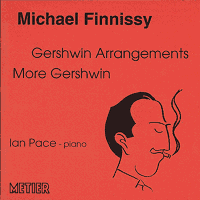|

GERSHWIN ARRANGEMENTS

PETER DICKINSON listens to Michael Finnissy as arranger

It was time for the late twentieth century to respond to Gershwin with
some new arrangements of his songs. Not jazz, where the whole thing gets
lost, but a more classical approach. Such arrangements could either be authentic,
in period style, or else radical. Anything in between - like some characterless
rearrangements heard in the BBC Proms in London a few years ago - is a waste
of time. As an arranger Finnissy is radical - as we should know from his
own music. So the stage is set on this CD for something special with pianist
Ian Pace, a dedicated exponent of Finnissy who performed the complete piano
works to mark his fiftieth birthday in 1996. Everything on this CD was premiered
by Finnissy himself - the Gershwin Arrangements in 1988 and More
Gershwin in 1990. The two sets are available from Oxford University
Press.
As an indication of the general style one might say that this is how
Charles Ives would have arranged Gershwin if he'd still been composing when
Gershwin wrote his songs. As in Ives the melody is there but the decoration
qualifies it in a fascinating way. With Finnissy you can practically always
hear the tunes, which are indestructible. Not all of these are familiar
and some which Finnissy has selected are difficult, if not impossible, to
find in print. Why on earth is there still no Collected Gershwin Songs easily
available?
Let¹s jump in at the deep end by listening to I'd rather Charleston
from Lady be good (added to the London production in 1926). It opens
with wild flourishes; then you can pick out the melody of the verse; and,
after more flourishes, the chorus follows with much of the 1920s spirit
(transmuted) of the original [listen - track 17, 0:00
- 0:55].
Finnissy is usually more meditative than that. Here's the first one in
the collection - How long has this been going on? (cut from Funny
Face but relocated to Rosalie in 1926). Here Finnissy ingeniously
mixes up the instrumental introduction to the verse, the verse itself and
the chorus in a kind of stream-of-consciousness idiom that's brushed past
Scriabin [listen - track 1, 0:00 - 0:40].
Another Gershwin classic is A foggy day in London town from the
1937 film A Damsel in distress. At the start Finnissy helps himself
to the chime chords of the introduction, then picks up the right-hand parallel
chords for the verse, but he constantly modifies the harmony with substitions
and additions [listen - track 3, 0:00 - 0:28].
This is what happens next in the chorus. There's the familiar till-ready
and then the tune but the harmonic backing is unpredictable, out of focus
[listen - track 3, 0:43 - 1:15].
Amongst Gershwin's lesser-known songs is the title song from the 1937
film Shall we dance. Although still recognizable this tune gets one
of the rougher treatments, elbowed into seven-beats-in-a-bar, and larded
with chords that might have come out of Messiaen. But the succeeding They're
writing songs of love, but not for me is melancholy and poetic [listen - track 7, 0:00 - 0:35].
The only song Finnissy uses which is also contained in Gershwin's published
set of 18 of his own transcriptions (1932) is his early 1919 hit Swanee,
one of the group of nine here called More Gershwin. The verse comes
first; then one rather straightforward (for Finnissy) run-through of the
chorus; another verse; another chorus, more subdued; and finally, avoiding
anything obvious, a magical rapt coda. You'd think the piece had finished
at 2'44" but it goes on to become one of the longest at 4'23".
But it's the chorus of Swanee that everyone knows best and Finnissy's
version gives a final indication of his personal angle on one of the greatest
melodists of the last century. Everything is beautifully played too [listen - track 20, 0:43 - 1:08].
Copyright © 30 July 2000
Peter Dickinson, Aldeburgh, UK
 CD INFORMATION - METIER MSV CD92030
PURCHASE THIS DISC FROM CROTCHET
VISIT THE METIER SOUND AND VISION WEBSITE
<< Music
& Vision home
Ikon of St Hilda >>
CD INFORMATION - METIER MSV CD92030
PURCHASE THIS DISC FROM CROTCHET
VISIT THE METIER SOUND AND VISION WEBSITE
<< Music
& Vision home
Ikon of St Hilda >>
 |
To listen to the aural illustrations in this review,
you may need to download RealNetworks' realplayer G2. |
|

